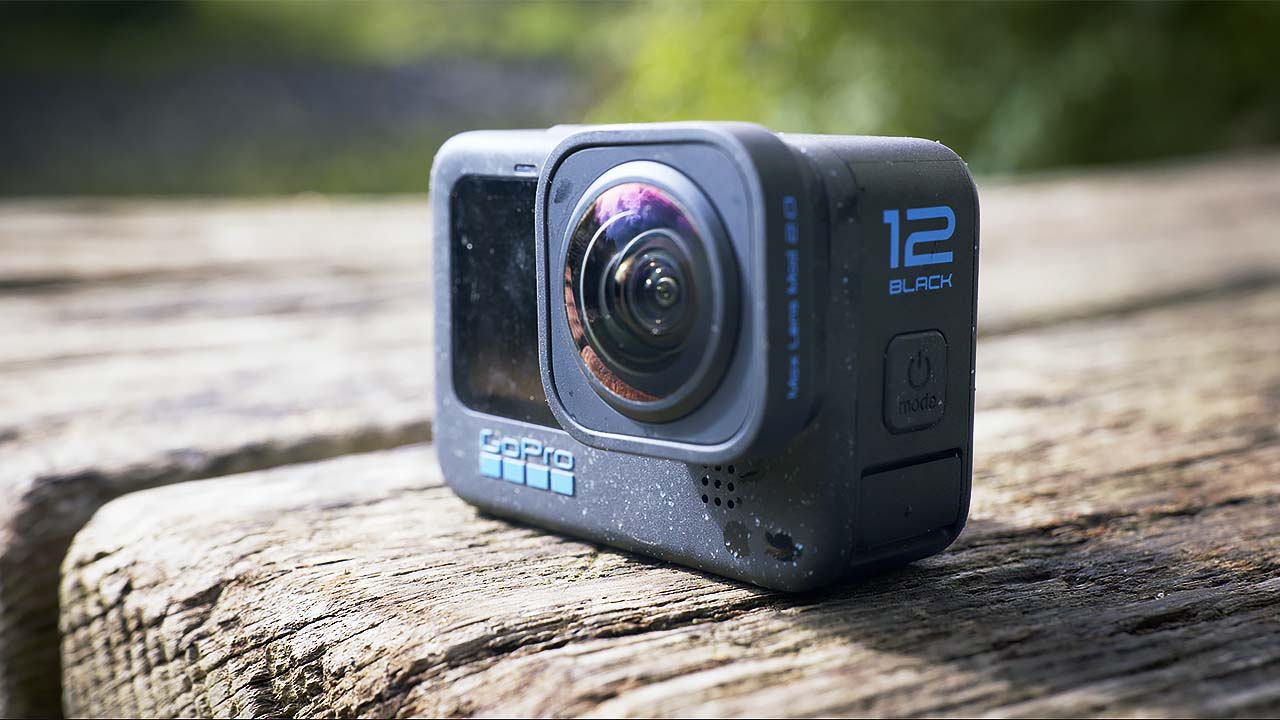
Simon Wyndham takes the GoPro HERO12 through its paces. With the market getting more crowded and more capable, can it remain the front-runner?
A lot of expectations have been placed on GoPro's HERO12, as there is every year when a new HERO comes out. However, this year is a bit different. DJI has previously released its Osmo Action 4, which, despite offering lower resolution, particularly in the stills department, really did offer a great alternative to the GoPro.
Of course, there are lots of unrealistic expectations, such as the desire by some for a 1-inch sensor, buoyed by a fake 'leak' on Elon Musk's X platform. Despite the less than realistic hopes, there were also more realistic ones, such as a new mounting system and fast charging. What made the cut? Read on...
What's actually new?
The first thing that you'll notice about the HERO12 Black is that it features a sort of paint splatter effect on the body. This has spawned more than a couple of spoof videos on YouTube about how to upgrade your HERO11 for the cost of a tube of paint or sparkles, but it does make a real point; the HERO12 is really no different internally from the HERO11. Most of the improvements seen in the camera have come about from efficiency gains in the firmware programming, and this is something that has irked some commentators.
That said, it's an important point worth mentioning that GoPro isn't the first company to have done such a thing, and it is doubtful it'll be the last. But, for existing HERO11 owners, it could be a source of frustration knowing that the hardware inside your existing cameras is capable of everything the new one can do. Or is it?
While I'm told most of the hardware inside the HERO12 is the same as the HERO11, there are some minor details that could still be different. For example, the chip that deals with Bluetooth inside the HERO12 can cater for four simultaneous device connections. It's uncertain whether the HERO11 could do this even with some reprogramming.
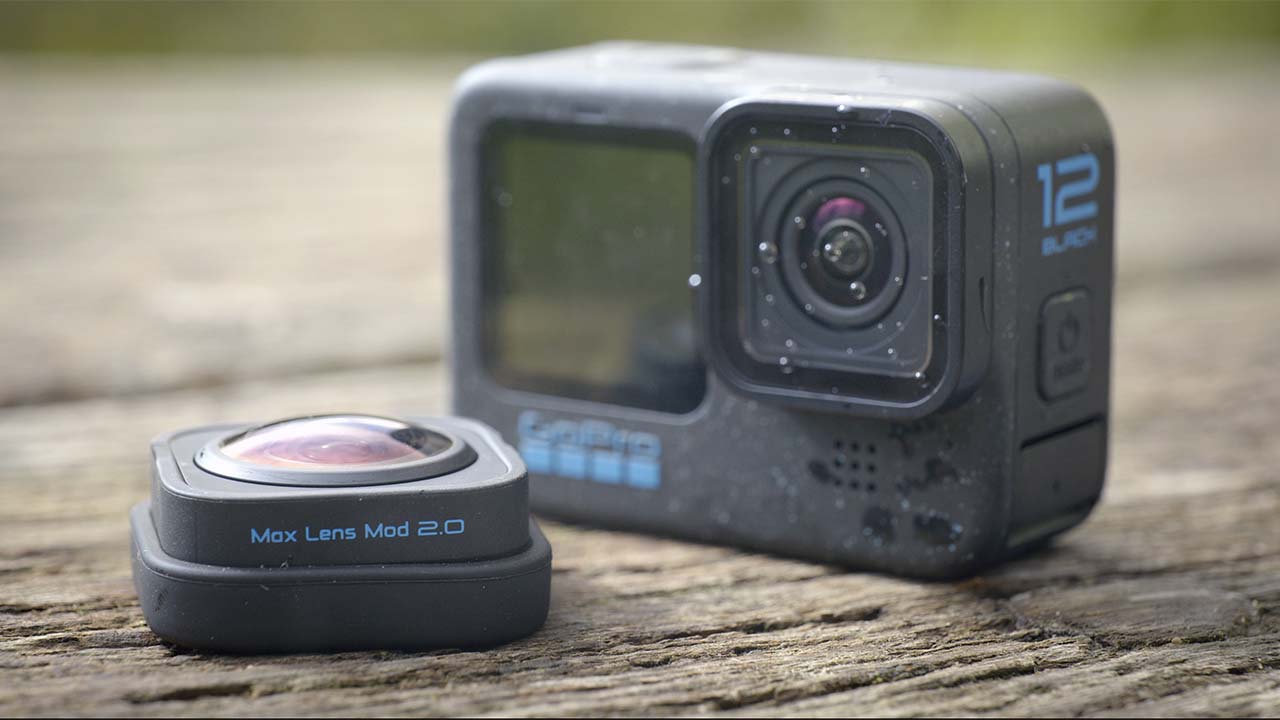
The GoPro HERO12 with Max Lens Mod 2.0
The GPS has also been taken out of the HERO12. GPS data was mainly used for adding things like data overlays onto footage, and GoPro says that only a minority of users were doing this. GPS is yet another battery drain, so it's now gone on the new camera, although it's not clear whether it has been physically removed or whether it has simply been disabled. So, while the two cameras may be mostly similar, there could still be minor differences.
Better battery life with less overheating is one of the headline features of the HERO12, along with Bluetooth microphone compatibility, HDR video, a new log picture profile, a new user interface, more efficient video encoding, interval photo mode, and biggest of all, the new Max Lens Mod 2.0. Lastly, a 1/4" screw thread has been incorporated into the base.
Redesigned user interface
The user interface has undergone a redesign on the HERO12, and there are some improvements, although it has also taken away options that I took for granted.
The positive aspect of the new interface is that it is pretty clear, although it still misses the directness seen on the DJI Action 4, which requires less navigation to achieve similar things. One thing I very much miss is the ability to place a quick access slow-motion icon on my saved profiles. It's there in the camera's "Easy" mode interface, but it's been taken away as an option in "Pro" mode. This is an icon I used a lot on previous GoPros because it saves me having to delve into menus to switch the camera into the slowest frame rate for any given resolution setting. Hopefully it's just a temporary omission that will reappear in any new firmware update.
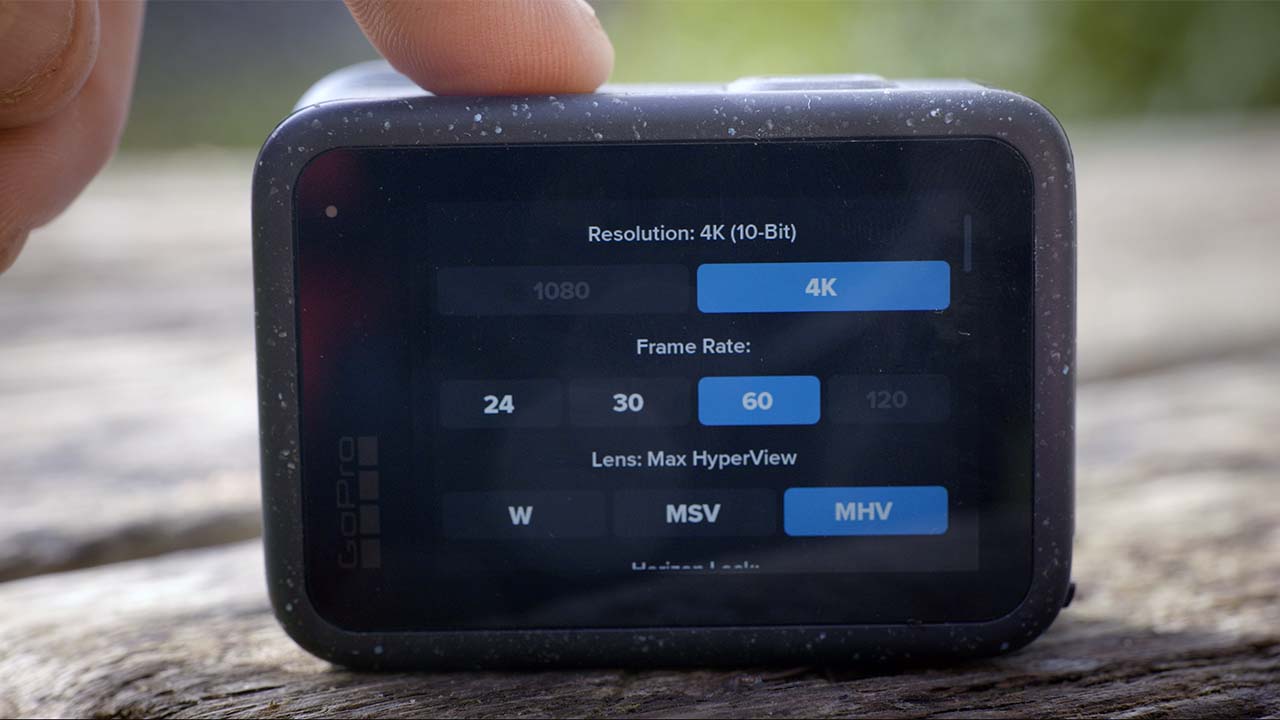
The UI on the HERO12 has been redesigned
Some good additions include a graphic display in the settings menu that shows you the remaining capacity of the SD card, along with how much footage has been uploaded to the cloud. There's an option to manage the storage so you can delete footage off the card that has already been uploaded if you're using GoPro's cloud storage subscription.
It is with mentioning the "Easy" mode as an option for less experienced users. Full control over the actual picture settings isn't given in this mode, but it does allow very fast and clear access to get the results you need. For example, if you want to shoot vertical video or slow motion, it just takes a tap or two to set the camera up.
Max Lens Mod 2.0
The new Max Lens Mod 2.0 is perhaps the most interesting aspect of the HERO12. For me, the wider the POV I can get, the better because it makes for a much more immersive first-person perspective. The original Max Lens Mod was a great addition to the line-up, but it lacked a hydrophobic coating and only increased the angle of view to 155-degrees. Max Lens Mod 2.0 ups that to a rather staggering 177-degrees, which effectively makes it one-half of a 360 camera. Not only that but recording with it can now take place up to 4K resolution rather than 2.7K on the older cameras.
Just an aside, the option to record at 2.7K with the Max Lens Mod (MLM) has been taken away, so your only options now are 1080p and 4K. GP-log and HDR mode recording are also not available currently when using the MLM. At least not by default. If you use the Labs firmware you can add a command to set the LOGB setting to 400, and hey presto, you have an equivalent of GP-Log with your MLM.
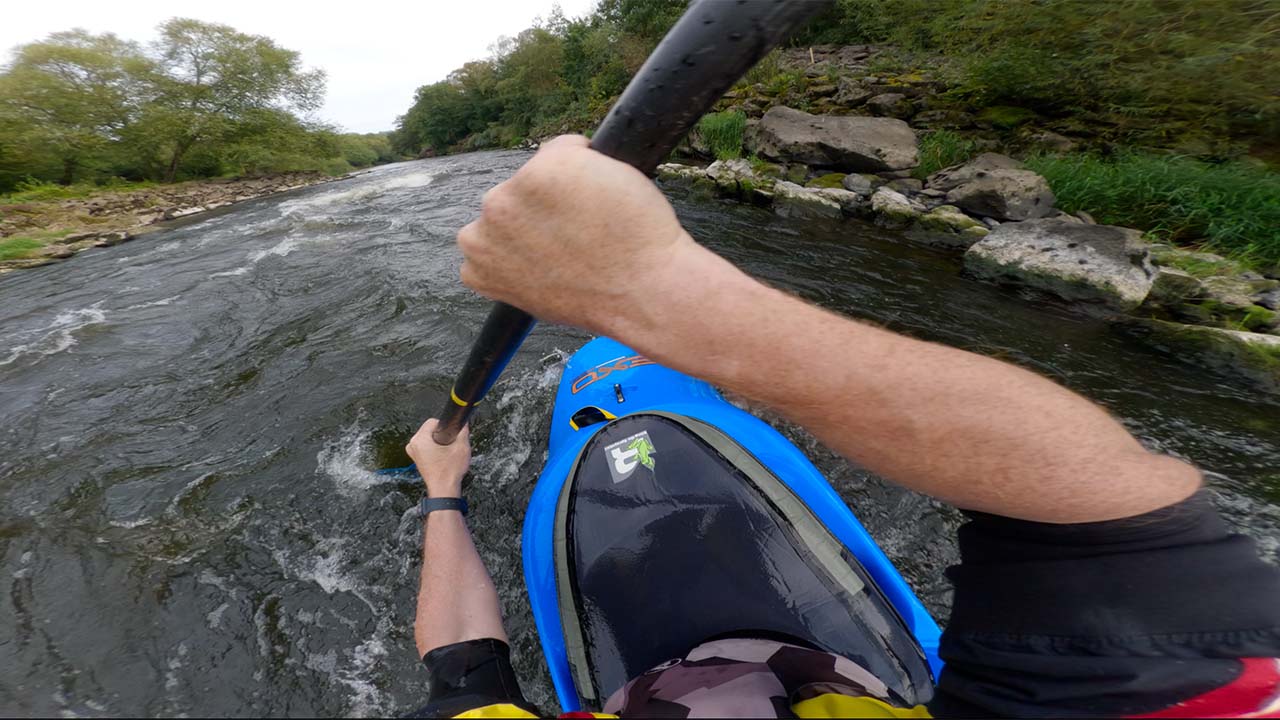
The Max Lens Mod 2.0 achieves an incredibly wide angle of view in Max HyperView mode
With all that said, I love using the MLM 2.0. The only way to get a wider angle of view is to use a 360 camera, and although the perspective can be quite distorted, for POV it is absolutely superb as long as you take care with the angle it's mounted at. I've found that if you keep it close to level rather than tilted, you get the best and least weird looking shots.
The hydrophobic coating worked very well to begin with, although the glass is still vulnerable. Despite the increased scratch protection, I still managed to ding it slightly with my paddle, causing droplets to now stick around that area. That said, any droplets that do form there tend to be small, rather than the great big view obscuring ones that used to appear on the old GoPros.
GP-log and HDR
For power users, the addition of GP-log will be a useful one. GP-log crams as much of the camera's dynamic range into the recording as possible, and needs to be graded in editing. It's very different from the old 'Flat' picture profile on the older GoPros, and certain functions are limited. For example, when it's enabled you can't go above ISO400. It's worth noting that if you have the Labs firmware installed, you can enable the wide colour gamut option, giving you even more grading potential when combined with the 10-bit recording. It's also worth noting that GP-Log sets the camera by default to a -EV of 2 stops under. This can create more mushy shadows than necessary, so I would suggest either using the LOGB command with Labs, or setting the EV with Labs to 0, along with reducing the noise reduction algorithms.
GoPro has created a LUT that can be installed in your NLE software for a basic colour correction, although it has been designed to be used with footage that has auto white balance enabled. However, I have found that it works quite well with a manually set white balance and then a minor hue correction applied.
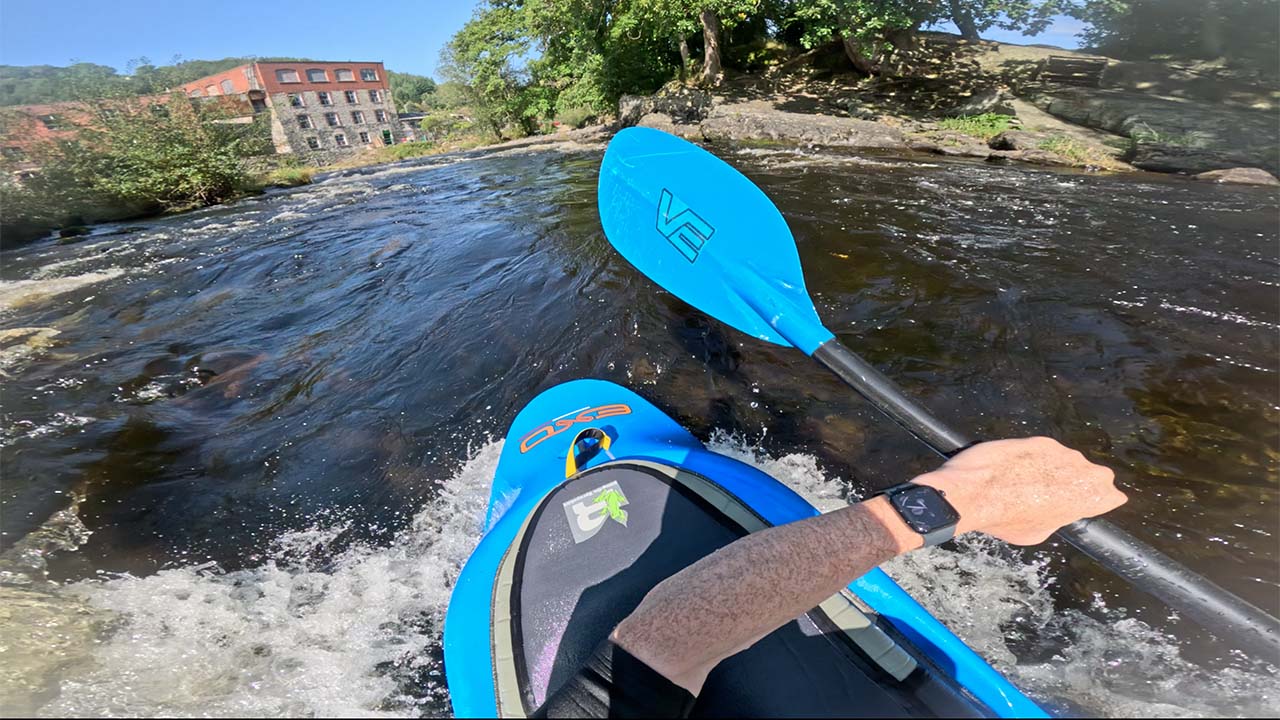
HDR mode gives a wide dynamic range, but can sometimes seem a little 'fake' and overdone in some circumstances
Another mode that can be used to get maximum dynamic range is the new HDR setting. This isn't designed to be used with an HDR television, but instead it combines two different video frames into one. As a result, your options for different frame rates are more limited in this mode. In very high contrast situations, it does make a marked difference. For example, if you're filming inside a car, the view outside and the sky will still be visible without blowing out.
If I had one issue with HDR mode, it's that in some circumstances it can look a little bit too much like one of those HDR photos that people take, with the effect being rather overdone. There's bio haloing, but sometimes the saturation levels can make it look a bit 'fake'. That being said, for general users, it's a way of capturing a lot of detail within an image in difficult lighting without the need for grading.
Bluetooth microphone compatibility
The ability to use a Bluetooth microphone was much hyped during the HERO12's announcement, and it's an interesting feature. Contrary to the impression that might be given, pretty much any Bluetooth mic can be used, not just earbuds like AirPods.
The idea behind it is that you can record audio to a separate audio track on the camera without being near it. So, you could mount the camera on your car bonnet and record audio from within the car. You can also issue voice commands to the camera using the mic as well.
For some casual users, the feature might come in handy, but the audio quality falls far short of what you'd need for a professional application. So, on a personal level, I can't see myself using it too much. On the other hand, if GoPro was to design a USB wireless receiver that was integrated into an alternative side door, with a waterproof mic that you could hook over your ear, I'd be very interested in that!
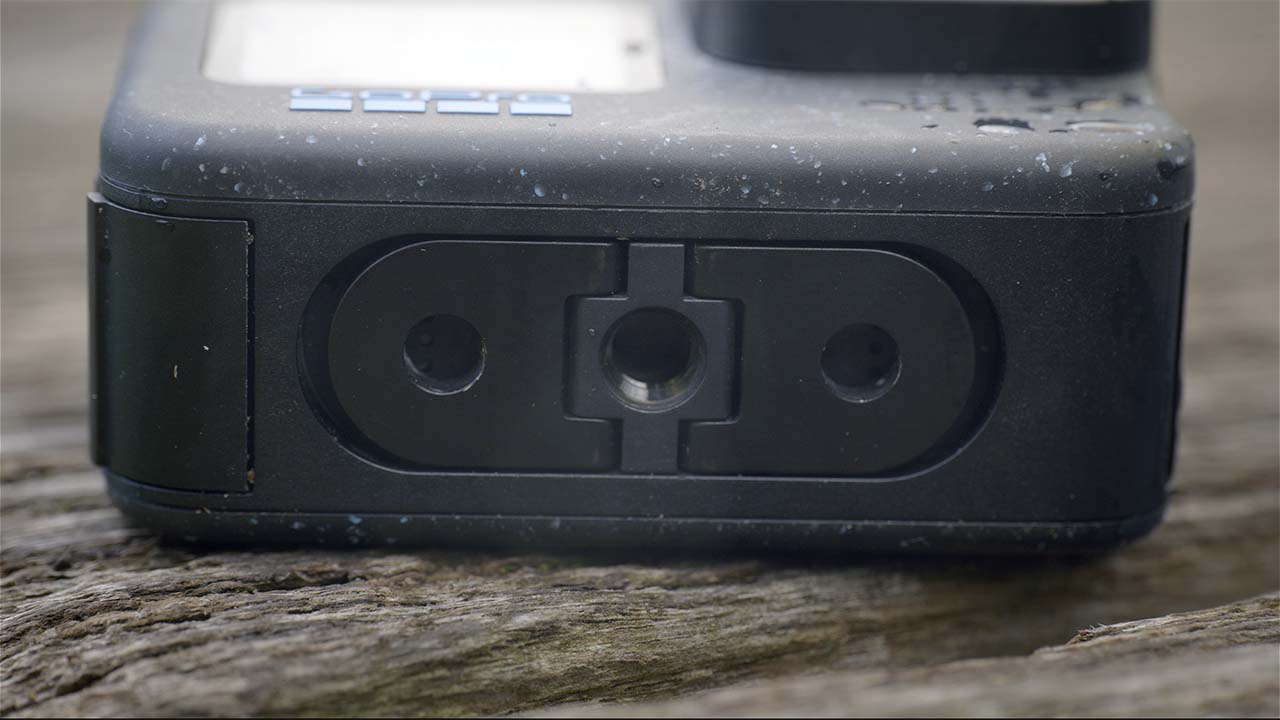
The 1/4" screw mount will please users who have been asking for it for quite some years now
Battery life and improved HyperSmooth
Battery life on the HERO12 is better than the HERO11, and that's because GoPro has made a lot of efficiency gains in the programming. Video encoding is now apparently far more efficient, and these gains translate into less work being done by the camera, which in turn means less heat generation and better battery life.
How much benefit you see will depend on the mode you use. Most of the gains to be had are when 5.3K/60 and 4K/120 are used, with the latter having a claimed battery duration of around an hour without thermal shutdown. In a static position with no airflow, you'll likely not see a difference. For example, I got around 19 minutes in my office before the camera did a thermal shutdown. When I used it outside on the water, however, I got a much longer duration of around 45 minutes or so. That's a bit shorter than the claimed figures, but it's still a lot longer than previously.
I'm still not convinced by the need for people to record everything at 120fps for long periods. But, apparently, people do, and I recently came across some kayakers who leave their cameras in 120p mode all the time, despite the fact that it canes the battery life.
HyperSmooth has also been improved. On previous cameras, it's been difficult to tell the difference between HyperSmooth versions since the stabilisation is now so good. But, the HERO12 has improved things, most notably when AutoBoost mode is used. AutoBoost detects how much stabilisation is needed in the shot, and tries to keep the crop to a minimum, only zooming in when it needs to. AutoBoost works amazingly well, and you never actually notice when it does need to crop in, since it does it so subtly.
The HERO12 's AutoBoost mode processes four times as much data as the HERO11, and, as a result, it manages to keep the FOV noticeably wider for any given amount of movement than the HERO11.
Lastly, as a very small aside, the release of the HERO12 has brought back live view while recording to the Quik app.
GoPro HERO12 conclusions
The GoPro HERO12, despite the lack of physical hardware upgrades, represents yet another increase in capability for the HERO series. My gut feeling is that the next major upgrade, including a new processor, may come in 2024. My reasons for thinking this is that we know that a new MAX360 camera is on its way, and the Max Lens Mod 2.0 has hinted at the possibility that the new 360 camera will be capable of 4K over captured video. The GP2 processor is being pushed to get a 4K image with the MLM 2.0, and so any new 360 camera will possibly need either two GP2 processors or an entirely new one.
So, my feeling is that most of GoPro's hardware development resources this past year have been put into the MAX360 2 camera, with the MLM 2.0 being a side result of that, with a major hardware change possible next year. I don't have any insider knowledge on that, so that's just pure speculation on my part, so we'll just have to wait and see what next year brings.
In the meantime, the question is whether you should upgrade to the HERO12 or to the DJI Osmo Action 4? While YouTube is full of videos proclaiming that the Action 4 is the new action camera king, I'm afraid that things, as always, are much more nuanced than that.
Clearly, if you fly DJI drones, it makes sense to combine it with a camera that has similar colour science. It also depends on whether you want to combine with other GoPro cameras, and how much of a power user you are.
I love the ultra-wide angle on the Action 4, but the MLM 2.0 gives a whole new level of POV that I absolutely love. On the other hand, the Action 4 has its incredibly fast magnetic mount system, fast charging that can charge 80% of power within 18 minutes, as well as a front touchscreen that makes changing settings in a front-facing setup really easy.
So, what are the advantages of the GoPro over the Action 4 in a nutshell? The MLM 2.0 is one for starters. If you take stills a lot, the 27MP raw photo ability of the GoPro is a clear advantage, and it shouldn't be underestimated how many people use action cameras for action stills rather than action video. The new Interval Photo mode is great for this, although in raw mode the minimal interval is 3 seconds rather than the 0.5 seconds that you can use in SuperPhoto or normal photo modes. 5.3K 8X7 video gives more flexibility in post for different outputs and reframing, as well as the ability to take 24.7MP stills from your video.
The last advantage the HERO12, and indeed the entire modern HERO series, has over rivals is the Labs firmware. Labs is the ace up GoPro's sleeve, and it gives users the ability to take control over pretty much every aspect of their camera. From giving it motion-triggered recording to full scheduled start/stop, custom log curves, access to wider colour gamut recording in all modes, custom file names and DaVinci/Premiere compatibly proxy file naming and folder structures, increased bitrates, noise reduction control and countless other controls and settings. It's a level of control that not everyone will need, but it is simply not available on any other equivalent camera, so it's well worth mentioning as a significant advantage. I have Labs installed on all my GoPros.
I've heard the HERO12 being labelled as the HERO11 "Pro", and that's kind of an apt analogy. The HERO12 definitely offers people who really like to tune their image more options, and the MLM 2.0 is amazing for POV use. In conclusion, whilst I was hoping the new camera would have a faster mounting system and possibly a wide lens built in, the HERO12 is the action camera you want to be using if you need complete control over its use in any environment. It's also the camera you want if you require the maximum resolution and reframing abilities.
The HERO12 is available from £399.99 on its own, or £475.98 with the Max Lens Mod 2.0.


Comments